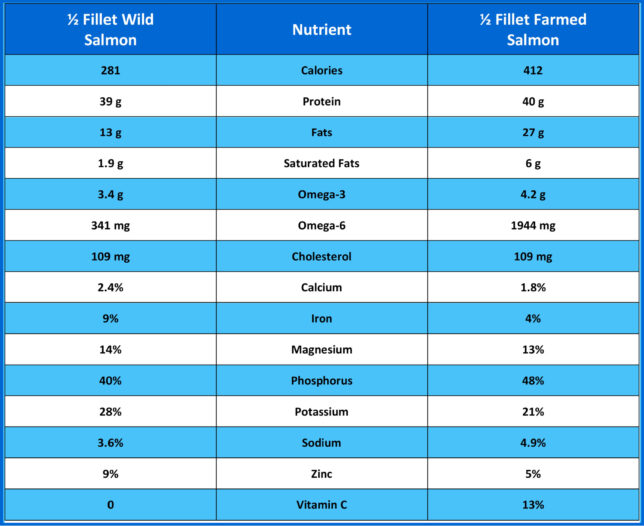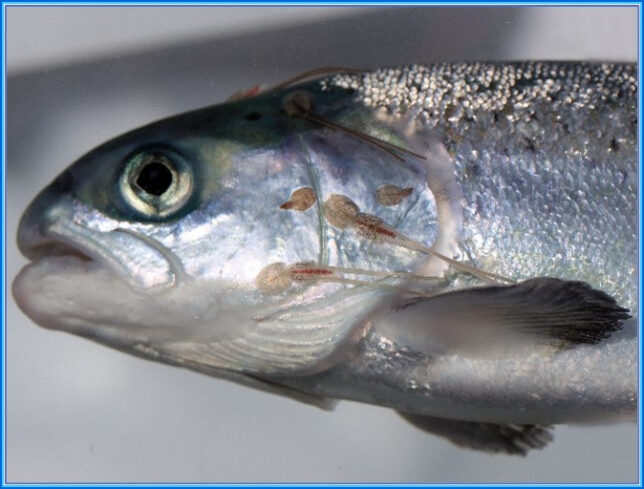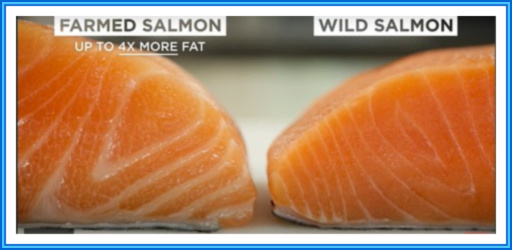A comedian once quipped, “I wanted to eat healthier, so I went on the Paleo Diet. You won’t believe it, but after just two weeks on it, I lost… the will to LIVE!”
Healthy food doesn’t mean you’re stuck eating bland rabbit food.
Whether you dine out, cook for pleasure, or a paycheck, it’s the quality of the food ingredients that make the healthiest impact. Start by selecting better ingredients and buying naturally grown food. Naturally produced food will always have better flavor, texture and contain more nutrients than mass-produced, hybridized, and over-fertilized food.
If you like to eat seafood and you enjoy fresh salmon, you’re about to discover why wild-caught is better and how you can spot it in the fish market or on your plate. It’s a big selling point for restaurateurs and helps give home chefs rave reviews.
Wild-Caught Salmon Has More Nutrients Fewer Calories
Farm-raised salmon gives a new meaning to “chicken of the sea.” They are under human control from egg to harvest. They swim far less than wild fish, and as a result, farm-raised fish contain more of the omega-3 and omega-6 fatty acids.
However, these fish have double the fat, up to 3 times more saturated fat, and 46% more calories per ounce due to the additional fat. That’s great if you’re a grizzly bear bulking up for hibernation, but not so good if you’re counting calories.

Because wild salmon travel thousands of miles, feeding in diverse ecosystems, the meat contains a higher mineral content, including potassium, zinc, selenium, copper, and iron.
Although there are nutritional differences, it’s the taste and texture that make the difference for most people who enjoy a salmon dinner. We’ll get into that in just a moment.
Health Concerns with Farmed Salmon
Salmon farming and other aquaculture is a better alternative than overfishing to feed our exploding world population. But with every new advance in food production, there is a tradeoff.
The three primary concerns for aquaculturists are pollution, contamination, and something called sea lice.
1. Pollution from the Pens
Any time you pack living animals in a confined space, there is a waste problem. Salmon pens are enclosed nets that float on the surface with an anchor at the bottom. The fish’s waste collects under the pens, blanketing the seafloor for up to a mile away with fine sediment that resembles volcanic ash. It coats everything and makes the area inhabitable for abalone and other creatures. Once the salmon are gone, it can take months for the plants and animals to recover in the immediate area.
2. Contamination from Human Pollution
The Washington State Department of Health4 notes that both farmed and wild salmon are safe to eat, although preliminary studies show an elevated PCB level in farmed salmon.
With rampant global pollution, wild salmon are not pristine either. They swim through the same polluted estuaries that flow past the penned salmon. Unfortunately, farm-raised salmon live in higher concentrations of pollutants than wild fish that can swim out to sea.
3. Sea Lice is a Global Problem
Yes, salmon get lice too. Sea lice are ocean parasites that attach to the skin like a leach and suck the salmon’s blood. Inside overcrowded salmon pens, sea lice colonies can multiply exponentially like a Florida beach on Spring Break.
Salmon farmers in the US, Canada, Scotland, Norway, and Chile have lost nearly $1 billion annually from these tiny crustaceans. The effect has caused the wholesale price of salmon to jump by 50% in most markets.
A recent study at one Canadian salmon farm uncovered that sea lice concentrations were 73 times higher than natural fish stocks.

Attempts to eradicate this pest include introducing other “feeder fish” to eat the lice, pumping the fish through warm water flumes to dislodge the lice and pesticides. As you might suspect, pesticides make the fish inedible for human consumption. Plus, after dumping so much of these chemicals into the water, the sea lice have become pesticide-resistant. You can see more in this Associated Press video, “Parasitic Sea Lice Disrupting Salmon Farms.”
Although not immune, wild-caught salmon have a much lower incidence of sea lice.
| “Many farmed salmon are fed food made from wild fish. To produce farmed salmon, it takes approximately three times their weight in wild-caught fish. This practice is not only unsustainable but adds to the concerns about how wild fish are caught and slaughtered.” – Compassion in World Farming |
Farm-Raised Salmon Have Other Parasites
Another unfortunate side-effect of salmon farming is a bacterial disease called Infectious Salmon Anemia (ISA). It attacks the gills and is 100% fatal to the fish.
The 1980s saw the spread of Furunculosis, another highly infectious disease, in fish farms. The bacteria Aeromonas salmonicida affects Atlantic salmon, producing boils on their sides. Researchers discovered that Furunculosis could spread between salmon farms up to 15 miles (24 kilometers) apart. This long-living bacterium persists in high concentrations of sediment under salmon pens.
Dr. Andrew Weil, a nutrition expert, insists, “Until salmon farmers clean up their acts, I still strongly recommend eating wild Alaskan salmon.”
Better Look and Taste
Just because a restaurant or wholesaler tells you they sell salmon caught in the wild, how can you be sure?
Here are some of the visual cues to use when comparing wild-caught salmon vs. farmed salmon:
Deeper Color
There are natural color differences between species like King (Chinook), Sockeye, Chum, and Coho. However, wild-caught salmon will have a deeper red color due to their varied diet. Farmed salmon will be a paler orange color.
Fat Lines
Since farmed salmon don’t move as much as their wild cousins, they have larger fat lines. A wild salmon’s meat is denser since they must hunt for their food, while farmed fish need only open their mouths as the food rains down on them.
This video shows the variations of fat and color between the two types of salmon.

Fins and Tail
If you can view the whole fish, you have some great clues as to its origin. As wild salmon use their fins and tails constantly, they will be well-formed and broader. Farmed fish continually bash into the net and one another so, their fins tend to be ragged or deformed.
This video, “Identifying Wild and Farmed Salmon,” shows the key differences so that you can recognize them in the shop.
Additionally, the scales tell the story, but you need a microscope. A fish scale is like a cross-section of a tree. A wild salmon will have rings of varying widths depending on seasonal feeding variations. The rings on a farm-raised salmon scale are nearly concentric because they feed all the time.
Better Flavor
The answer to whether the taste is better depends on your taste and preference. Everyone prefers a little different texture and flavor.
Overall, farm-raised will be fattier with a softer, flakier flesh and milder flavor. On the opposite side, wild salmon has firmer, denser meat, less fat, and a pronounced salmon flavor. Let your taste buds decide.
Wild Caught Salmon Is Available All Year Round
Depending on the species, most of the wild salmon harvested occurs in June and July. However, it can last through the end of September. For example, you can still find fresh Alaskan Copper River Coho through the end of September and the beginning of October. There is also a small amount of troll-caught Alaska King salmon harvested commercially from October to April.
If you’re seeing fresh salmon outside of those months, most likely it’s farm-raised. Your best bet for quality wild salmon is to buy flash-frozen wild-caught salmon or canned sockeye (red) salmon for your dishes.
Is Wild-Caught Salmon Truly Wild-Caught?
In 2016, Miami-based seafood company MKG Provisions, a.k.a. UpRiver Aquaculture, was fined $50,000 along with three years of probation after pleading guilty to falsely labeling cases of salmon. The maximum penalty for mislabeling seafood is up to 5 years in prison.
Despite the stiff penalties, mislabeling continues around the country. In a comprehensive 2015 report by Oceana, the mislabeling of salmon is rampant.
U.S. retail mislabeling was more common when salmon was out-of-season. The analysis of the winter salmon purchases revealed the following findings:
- 43% of the salmon samples tested were wrong and mislabeled.
- The most common form of mislabeling was describing farmed Atlantic salmon as “wild-caught salmon.”
- Restaurants were three times more likely to misrepresent the salmon than grocery stores. (67% vs. 20%)
Researchers found six instances in which Atlantic salmon replaced high-value Chinook or King salmon. The report cites vague names, like “wild,” “Alaskan,” and “Pacific,” tend to have higher mislabeling rates.
To protect yourself, know how to identify the differences and buy from a trusted source.
Restaurants That Serve Wild Salmon
Restaurants are proud to serve wild-caught salmon and will advertise it on their menu. If the menu doesn’t specify “wild-caught,” it’s not. Reputable restaurants won’t risk their reputation by doing a bait and switch. They buy direct from a wholesaler who has a connection to a reputable source.
Get the Best Source of Wild Salmon
Most of the wild salmon fisheries for North America are in the Northwest, from Washington to Alaska. U.K. salmon lovers will opt for Scottish salmon, and in other parts of Europe, they want Norwegian.
Wild-caught salmon from any of these fisheries is a winner for dinner.
The right question is, “What is the best type of Salmon?”
The following chart shows the commercially available salmon species from the Pacific Northwest:

Where to Buy Wild Salmon?
It’s not always easy to buy fresh wild-caught salmon unless you live near the sources. Look for it in the freezer section of the larger grocery retailers and wholesale club stores. You can also purchase them online through reputable seafood vendors.
Vital Choice is an Alaskan seafood supplier and a certified B-Corporation adhering to ecological best practices. They can identify each fish’s exact origin and which company processed it no matter what state or country it originated. They are a reliable source for all types of wild-caught salmon and other seafood.
Contact your local seafood wholesaler. They should be able to get it for you, especially if you are buying it regularly. The quality of the fish is worth the effort.
| Are you a seafood processor, wholesaler, or restaurant searching for a writer to help peddle your equipment or products? Contact Bill or Norela Grover through our Contact Us page. |
